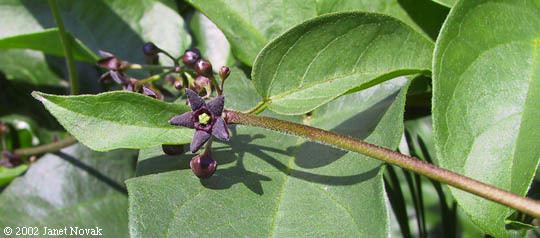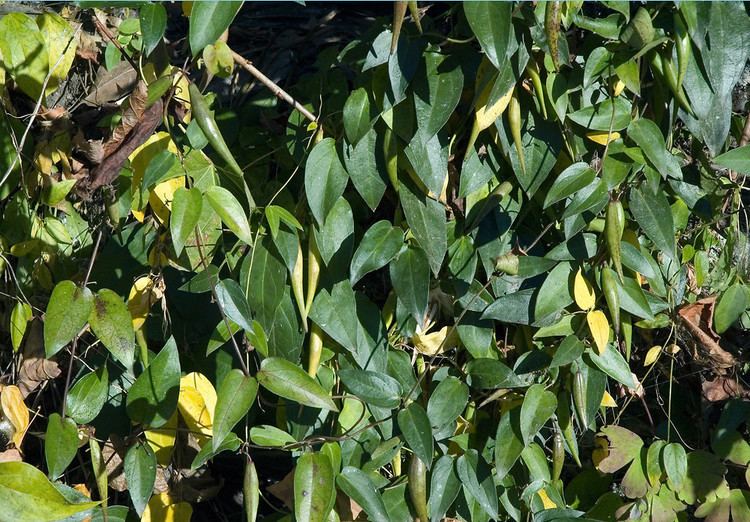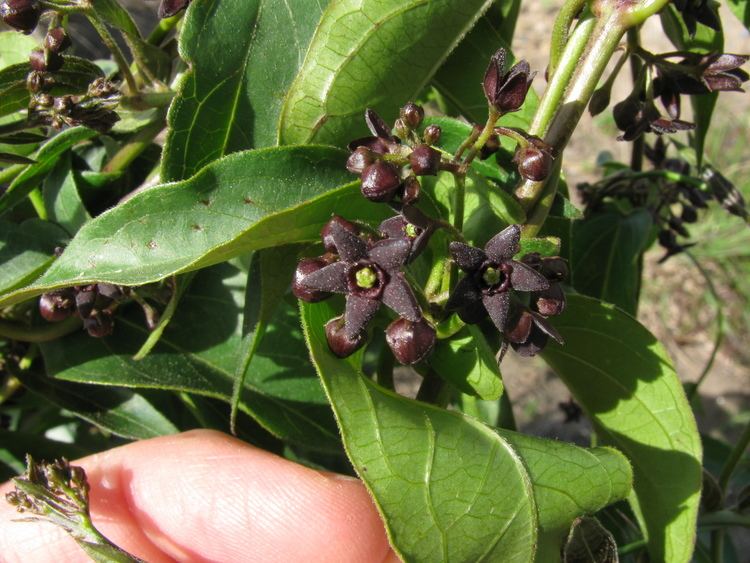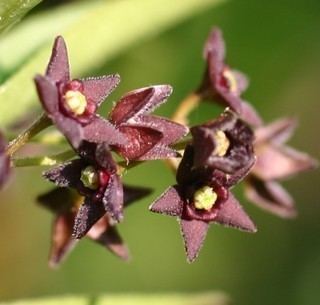Kingdom Plantae Family Asclepiadaceae Scientific name Cynanchum louiseae Rank Species | Order Gentianales Genus Cynanchum Higher classification Cynanchum | |
 | ||
Similar Cynanchum rossicum, Cynanchum, Lonicera morrowii, Microstegium vimineum, Asclepiadoideae | ||
Cynanchum louiseae, a species in the milkweed family, is also known as black swallow-wort, Louise's swallow-wort, or black dog-strangling vine. Cynanchum louiseae is a species of plant that is native to Europe and is found primarily in Italy, France, Portugal, and Spain. It is an invasive plant species in the northeastern United States, parts of the Midwest, southeastern Canada, and California.
Contents
- Description
- Habitat
- Reproduction
- Invasiveness
- Ecological implications
- Management
- Chemical
- Manual
- Mechanical
- Biological
- References

Description

Cynanchum louiseae is a perennial, herbaceous vine with oval shaped leaves that have pointed tips. The leaves are 3–4 inches (7.6–10.2 cm) long, and 2–3 inches (5.1–7.6 cm) wide, occurring in pairs on the stem. The flowers have five petals, and are star-shaped with white hairs. The flowers range in color from dark purple to black. The fruit of Cynanchum louiseae is a slender, tapered follicle that ranges in color from green through light brown and is tightly packed with seeds attached to puffy fibers.
Habitat

Cynanchum louiseae tends to grow in upland areas and is tolerant to variable light, salt, and moisture levels. In the United States, the vine is often found in abandoned fields, hedgerows, brushy areas, woodlands, river banks, transportation corridors, quarries, agricultural fields, and gardens. In gardens, the plant is seen as a fast-growing weed.
Reproduction

Cynanchum louiseae emerges from an underground stem in the spring, and flowers during June and July. Cynanchum louiseae is self-pollinating, and follicles form throughout the summer. The number of follicles formed is directly linked to the amount of light the plant receives. If there is a lower level of light, then there are fewer follicles compared to a plant exposed to a higher level of light. The seeds begin to be released by mid-August, and continue to be dispersed by air currents into early October.
Each seed is polyembryonic and contains about one to four embryos per seed, increasing Cynanchum louiseae's proliferation. Seeds have delicate fibrous "parachutes" used in wind dispersal over long distances. In addition to seeds for reproduction, Cynanchum louiseae also uses rhizomes as a method of propagation, meaning that the plant clones itself underground and produces new plants. After seed dispersal, the plant dies to the ground in the winter, reappearing in the spring.
Invasiveness
The first sighting of Cynanchum louiseae in North America was recorded in Ipswich, Massachusetts in 1854. In 1864, a plant collector recorded that it was "escaping from the botanical garden where it is a weed promising to be naturalized". Cynanchum louiseae escaped from a garden in the Cambridge area of Massachusetts and naturalized in the surrounding states and is still spreading today. Massachusetts and New York classify the plant as an invasive species. Beyond the northeastern US, the plant has been reported in Wisconsin and California.
Ecological implications
In the United States and Canada, Cynanchum louiseae is a threat to native species because it crowds them out. For example, it can completely replace a field of native goldenrod. Crowding out other species results in a reduced habitat for wildlife, which may become endangered because they can no longer find their optimal habitat.
Cynanchum louiseae threatens the rare limestone pavement barren ecosystems by crowding out plants that the native wildlife needs to survive. It may also decrease bird presence in grasslands, which may in turn cause certain insect species populations to increase.
In Vermont, Cynanchum louiseae crowds out the endangered species Jessop's milk vetch. In Rhode Island, Cynanchum louiseae has been reported as reducing the effectiveness of electric fences, which may allow livestock to be put into danger or lost.
In addition, Cynanchum louiseae crowds out a species of milkweed that monarch butterflies use as their larval food plant. Thus, the spread of this plant threatens populations of monarch butterflies. Overall, Cynanchum louiseae reproduces very prolifically, and can easily take over various habitats in a short time. Most of the possible implications of Cynanchum louiseae's changing the structure of various ecosystems have not yet been studied.
Management
There are four methods of management that can possibly be used for the management of Cynanchum louiseae. These methods are chemical, manual, mechanical, and biological. Only the chemical, manual, mechanical methods are actually used in the United States and Canada. The biological method may be used in the future. Overall, early detection and removal is the best management strategy.
Chemical
The best chemical management of Cynanchum louiseae is through the use of systemic herbicides which prevent seeds from being viable. Garlon 4 (tridopyr ester) and RoundUp Pro (glyphosate) are the main systemic herbicides that are used to control the vine. The systemic herbicide is most effective when sprayed on the plant after flowering has begun. If the herbicide is used after follicles have formed, it is less effective because viable seeds may still form. The most effective treatment using systemic herbicides is through a cut stem application, consisting of applying the chemical to the recently-cut stems of the swallow-wort vines.
Manual
Manual management is the removal of Cynanchum louiseae from the ground by digging up its rhizomes so that the plant cannot reproduce. The vine has an extensive rhizome system which must be completely removed to prevent new shoots from growing. Trying to remove the vine by pulling will often cause the plant to detach from its rhizome, allowing the vine to continue to grow new shoots. Seed pods must be disposed of carefully, to avoid inadvertently spreading the seeds to new areas.
Mechanical
Mechanical management is the mowing down of Cynanchum louiseae. This method does not stop growth, but it does stop seed crops. No seed crop means that the plant has no offspring.
Biological
Biological management in the use of the vine's natural enemies to stop the spread and diminish the population of Cynanchum louiseae. In the United States, Cynanchum louiseae has no natural enemies, but in its native Europe, certain caterpillars, beetles, and diseases attack the plant. Researchers at Cornell University and the USDA have investigated the use of natural enemies as a way to control the plant. The use of natural enemies is controversial, because the implications of adding more non-native species to threatened areas is unknown. In 2014 Hypena caterpillars were released in Ontario, Canada to help control Cynanchum's spread.
